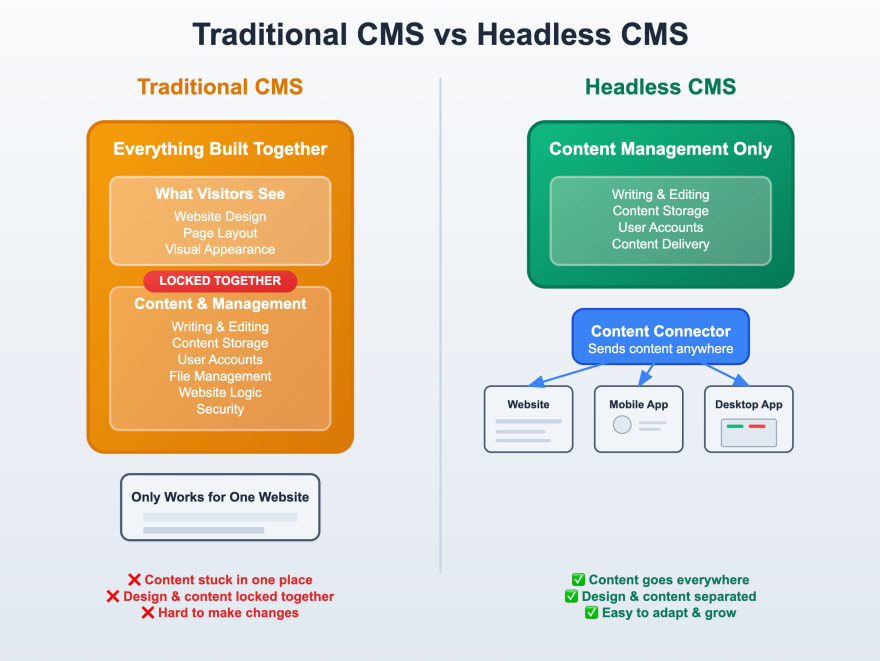When people hear “content management system” (or CMS), they often think of platforms like WordPress, Wix or Squarespace — systems that both store content and control how the website looks and works. While those platforms are fine for some situations, they aren’t always the best option when it comes to performance, flexibility and security.
A headless CMS is a modern approach that separates content management from website design and delivery. This separation offers greater flexibility, faster performance and better security, making it easier to build fast, reliable websites that are simple to update.
This newer method is quickly becoming the preferred choice for many websites, especially small business sites, portfolios and blogs that need a hassle-free way to manage their content.
What Is a CMS and What Does “Headless” Mean?
A Content Management System (CMS) is a tool that lets you manage your website’s content — things like text, images and blog posts — without having to edit code.
Traditional platforms like WordPress are examples of monolithic CMSs. They handle everything: storing your content, displaying it on your site, managing plugins, themes and more.
But with all that bundled together, you also inherit some common problems — slower performance, security vulnerabilities and bloated code that you often don’t need.
A headless CMS works differently.
- It stores your content, like any CMS.
- But it doesn’t control how your website looks or functions — that part is completely separate.
- The content is delivered through an API (a kind of digital bridge), which connects to your custom-built website.
Think of it like this:
Traditional CMS = Content + Website + Plugins (all in one package)
Headless CMS = Content only (website built separately)
This setup is known as “headless” because the CMS doesn’t have a built-in “head” — meaning the front-end design.

Why Use a Headless CMS?
Here are the key benefits of choosing a headless CMS for modern websites:
✅ Faster, More Secure Websites
A headless CMS doesn’t load bulky themes, plugins, or a bloated backend system every time someone visits your site. This means your website runs faster and has fewer points of attack for hackers.
✅ Full Design Freedom
Because the front-end is completely separate, there are no restrictions from templates or plugin limitations. This allows for fully custom website designs that connect seamlessly to the content.
✅ Easy Content Editing
You still get a user-friendly dashboard where you can log in and edit text, update images, or publish blog posts.
It’s simple, clean, and focused on just what you need, without all the clutter you’d get from a traditional CMS.
✅ Future-Proof and Flexible
With a headless CMS, your content isn’t locked into one platform.
You can easily reuse it across different websites, apps, or even future projects if needed.
How I Use a Headless CMS for Client Projects
When building a website, I focus on performance, security and user experience. Using a headless CMS fits perfectly with this approach.
- I create a fast, streamlined website using modern frameworks like Astro.
- I connect a headless CMS that makes it easy for you to update your content.
- You get shown exactly how to use it, so you can make updates confidently without worrying about breaking anything.
This setup means you get the best of both worlds — a professionally built website with the freedom to manage your content whenever you need.
Is a Headless CMS Right for Your Website?
For most small business websites, portfolios and blogs, a headless CMS is a smart choice.
It gives you:
- A fast, reliable website
- Easy content editing
- Better security
- More flexibility for the future
A headless CMS offers the right balance of performance, security and easy content management, making it the ideal choice for most websites seeking a modern and flexible solution for managing content online.
Posted by AH WebTech